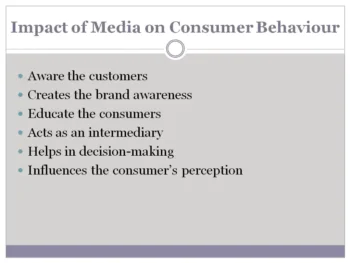Impact of media on consumer Behaviour
The impact of media on Consumer Behaviour is as follows:
- Beware the Customers
- Creates Brand Awareness
- Educates Consumers
- Acts as an Intermediary between Consumer and Company
- Helps in Decision Making
- Influences the Consumer’s Perception
1) Beware the Customers
Websites such as CompareIndia and Naaptol exist to guide consumers in their choice of products and services, locally and nationally. The consumerism adage “Buyer Beware” is needed more than ever as the power of all media to influence inform and impact consumerism continues to grow exponentially, and more individuals have access to that media, with fewer controls in place to scrutinise what is true or respectable.
2) Creates Brand Awareness
Media can shape who customers are as both public and private people. The adage one is what he consumes, should apply to media as much as it does to food. A celebrity wears a certain clothes ensemble or mentions the manufacturer, designer, or store where it was purchased and nearly immediately, sales for that item increase. Celebrity endorsers bring instant receptivity and brand awareness even if indirect. Advertisers pay to get their products conspicuous placement on movies and T.V. because they believe these seemingly non-commercial associations will lead to positive uplift and eventually sales.
3) Educates Consumers
As customers progress into the 21st century, communications are becoming faster and faster and faster. Think of the millions of different media images people are bombarded with every day. It is as crucial now to be able to read and make sense of those images, as it has been to be able to read ordinary text. If consumers do not know how to read the messages coming at them from T.V., the internet, advertising, etc., then people may become very lost in the modern world. Print media are educating people about the product, and brand and enable them to choose the right product. Customers are becoming more educated and they search for information before making a purchase. Print media provide them with information and help them in selecting the right product.
4) Acts as an Intermediary between Consumer and Company
Media is leading people, especially the young, into living a consumerist lifestyle. Spending ridiculous amounts of money on items they do not need, creates a “cool” factor about that product or they just feel they “need” it. Media is the different types of technologies that are made to reach mass audiences. The most common ones are the internet, television channels, radio transmissions, newspapers, magazines, billboards, pamphlets and others. Through these organisations. firms and people reach out to sell or make their products or themselves known. On the other hand, consumers depend upon the media for information regarding products and companies.
5) Helps in Decision Making
Social media (social networking sites, microblogs, blogs, consumer review sites, content community sites, wikis, Internet forums and location-based social media) is all about enabling people to express and share ideas and thoughts with others, social media has removed spatial and time constraints that were inherent in traditional methods of communication; provided online tools that enable one too many sharing of multimedia content and employ easy to use interfaces that enable even non-specialists to share and connect each other. Social media became influential networks of consumer knowledge that affect consumer behaviour. In tourism, social media seem to play an important role in information search and decision making, especially due to the experiential nature of tourism products.
6) Influences the Consumer’s Perception
Media is such a part of our daily lives that a person does not even realise it is influencing us in big and small ways. Media use in advertising is purposely designed to elicit a change in consumer belief, action, and perception. It unabashedly woos us to buy products one does not need and trust wholly with product claims that are puffery or exaggerated. While it is commonly known that customers are being swayed for commercial reasons, the consuming public allows these forays because the media pays for shows on television or music on the radio as well as the information and news they read in newspapers and magazines.
Related Articles:
- nature of marketing
- difference between questionnaire and schedule
- features of marginal costing
- placement in hrm
- limitations of marginal costing
- nature of leadership
- difference between advertising and personal selling

You May Also like:-
Impact of social media on consumer behaviour
Factors Influencing Consumer Behaviour
PsychoanalyticTheory of Perception
Difference between consumer and customer
